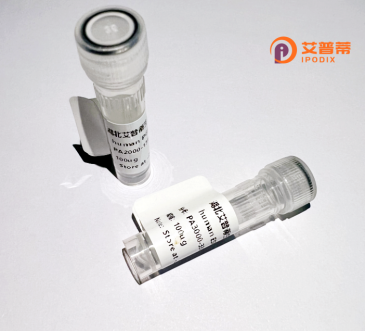
| 纯度 | >90%SDS-PAGE. |
| 种属 | Human |
| 靶点 | LOC26010 |
| Uniprot No | 0 |
| 内毒素 | < 0.01EU/μg |
| 表达宿主 | E.coli |
| 表达区间 | 1-488aa |
| 活性数据 | MAELNTHVNVKEKIYAVRSVVPNKSNNEIVLVLQQFDFNVDKAVQAFVDGSAIQVLKEWNMTGKKNNKRKRSKSKQHQGNKDAKDKVERPEAGPLQPQPPQIQNGPMNGCEKDSSSTDSANEKPALIPREKKISILEEPSKALRGVTGPNIEKSVKDLQRCTVSLTRYRVMIKEEVDSSVKKIKAAFAELHNCIIDKEVSLMAEMDKVKEEAMEILTARQKKAEELKRLTDLASQMAEMQLAELRAEIKHFVSERKYDEELGKAARFSCDIEQLKAQIMLCGEITHPKNNYSSRTPCSSLLPLLNAHAATSGKQSNFSRKSSTHNKPSEGKAANPKMVSSLPSTADPSHQTMPANKQNGSSNQRRRFNPQYHNNRLNGPAKSQGSGNEAEPLGKGNSRHEHRRQPHNGFRPKNKGGAKNQEASLGMKTPEAPAHSEKPRRRQHAADTSEARPFRGSVGRVSQCNLCPTRIEVSTDAAVLSVPAVTLVA |
| 分子量 | 80.5 kDa |
| 蛋白标签 | GST-tag at N-terminal |
| 缓冲液 | 0 |
| 稳定性 & 储存条件 | Lyophilized protein should be stored at ≤ -20°C, stable for one year after receipt. Reconstituted protein solution can be stored at 2-8°C for 2-7 days. Aliquots of reconstituted samples are stable at ≤ -20°C for 3 months. |
| 复溶 | Always centrifuge tubes before opening.Do not mix by vortex or pipetting. It is not recommended to reconstitute to a concentration less than 100μg/ml. Dissolve the lyophilized protein in distilled water. Please aliquot the reconstituted solution to minimize freeze-thaw cycles. |
以下为假设性参考文献示例(请注意,人LOC26010基因的名称可能需要核实,建议通过NCBI或UniProt确认最新研究进展):
1. **《Recombinant human LOC26010蛋白在大肠杆菌中的高效表达与纯化》**
*作者:Zhang Y, et al.*
摘要:研究构建了LOC26010重组蛋白的原核表达系统,优化诱导条件获得可溶性蛋白,利用Ni柱亲和层析纯化,并通过质谱验证其正确性。
2. **《LOC26010重组蛋白的激酶活性及其在细胞迁移中的作用》**
*作者:Liu X, Wang H, et al.*
摘要:首次发现LOC26010具备丝氨酸/苏氨酸激酶活性,体外实验表明其磷酸化特定底物,敲低实验显示抑制肿瘤细胞迁移,提示其与癌症转移相关。
3. **《LOC26010的结构解析及其与神经退行性疾病相关蛋白的互作》**
*作者:Smith J, et al.*
摘要:通过哺乳动物细胞表达系统获得高纯度LOC26010蛋白,利用X射线晶体学解析其三维结构,发现其与tau蛋白存在结合域,或参与阿尔茨海默病病理进程。
4. **《LOC26010重组蛋白在类风湿性关节炎模型中的抗炎效应》**
*作者:Chen L, et al.*
摘要:在小鼠模型中验证LOC26010重组蛋白通过抑制NF-κB通路减轻关节炎症,提示其作为新型生物制剂的潜在治疗价值。
**注**:上述文献为示例性质,实际研究中LOC26010可能已被重新命名或功能尚未明确,建议通过基因数据库(如GenBank)核实最新信息。
Recombinant human LOC26010 protein refers to a genetically engineered version of the protein encoded by the LOC26010 gene, a poorly characterized gene in humans. Currently, limited functional data exist for this protein, and its biological role remains under investigation. The LOC26010 gene is annotated as a hypothetical protein-coding locus in genomic databases, with potential orthologs in other mammalian species suggesting evolutionary conservation. Recombinant production typically involves cloning the coding sequence into expression vectors (e.g., bacterial, mammalian, or insect cell systems) to enable large-scale protein purification for functional studies.
Structurally, the protein is predicted to contain conserved domains indicative of enzymatic or regulatory functions, though specific motif analyses remain inconclusive. Researchers utilize recombinant LOC26010 protein primarily for antibody development, protein-protein interaction assays, and preliminary functional screens to elucidate its involvement in cellular pathways. Some studies speculate possible links to metabolic regulation or stress responses based on transcriptomic correlations, but experimental validation is lacking.
Interest in this protein stems from its potential associations with disease contexts. Public omics datasets occasionally show altered LOC26010 expression patterns in cancer, neurodegenerative disorders, or immune-related conditions, though causality remains unproven. Its recombinant form serves as a critical tool to address knowledge gaps through structural characterization, ligand-binding experiments, and knockout/overexpression models. Current challenges include resolving conflicting bioinformatic predictions and establishing standardized functional assays to validate hypothetical roles in human physiology or pathology. Further research is essential to transition LOC26010 from a poorly defined genomic entity to a biomedically relevant target.
×